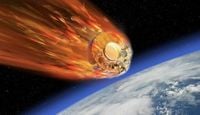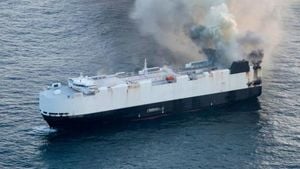As the world watches the skies, the uncontrolled re-entry of Kosmos 482, a Soviet Venera landing capsule, is expected to occur between May 9 and May 11, 2025. Launched on March 31, 1972, this spacecraft was originally designed to explore Venus, but due to a rocket malfunction, it has been trapped in a decaying low Earth orbit for over five decades.
The spacecraft consists of a 3.5-meter-tall carrier bus and a spherical lander weighing 495 kg, engineered to withstand the extreme conditions of Venus, including temperatures of 470°C and atmospheric pressures 90 times that of Earth. "This lander represents cutting-edge technology for its time," said Marco Langbroek, a space traffic expert at Delft Technical University in the Netherlands.
However, the spacecraft’s journey took a wrong turn shortly after launch when a critical engine burn failed, leaving it unable to escape Earth's orbit. Over the decades, atmospheric drag gradually lowered its orbit from an initial apogee of 9,000 km to around 2,000 km, setting the stage for its impending re-entry.
According to scientists, the re-entry could happen anywhere between 52°N and 52°S latitude, encompassing a wide range of landmasses, including parts of the United States, Canada, Europe, and Africa. Specifically, in the U.S., the potential impact zone stretches from southwestern Louisiana through several states, including Mississippi, Alabama, Tennessee, and all the way to Maine. The Aerospace Corporation, which monitors space debris, has indicated that impact is expected within four hours of 1:46 AM ET on May 10, 2025.
Unlike most space debris that burns up upon re-entry, Kosmos 482's titanium shell and heat shield were designed to endure the harsh conditions of Venus, making it more likely to survive its descent through Earth's atmosphere. If it does survive, it could strike the Earth at approximately 240 km/h (150 mph), with kinetic energy comparable to that of a 40-cm meteorite fragment. Dr. Jonathan McDowell, an astrophysicist at the Harvard-Smithsonian Center for Astrophysics, reassures the public, stating, "There is no need for major concern. The Earth is mostly ocean and unpopulated, so anyone in the ‘danger zone’ is pretty safe. Still, you wouldn’t want it bashing you on the head.”
The re-entry of Kosmos 482 brings back memories of the 1978 incident involving Kosmos 954, a Soviet nuclear-powered reconnaissance satellite that scattered radioactive debris across northern Canada. That event prompted a massive cleanup operation and resulted in a bill of $6 million sent to Russia, of which only half was paid. The Canadian government invoked international treaties to hold the Soviet Union accountable for the damages caused by the crash.
As Kosmos 482 approaches its re-entry, experts are closely monitoring its trajectory. The European Space Agency (ESA) has been tracking the spacecraft and providing updates on its potential landing locations. The ESA's latest predictions suggest that the spacecraft could re-enter Earth's atmosphere as early as 08:16 UTC (10:12 CEST) on May 10, 2025, but with an uncertainty margin of ±8.61 hours.
While concerns about potential damage from the spacecraft are valid, the annual risk of an individual being injured by space debris is estimated to be under one in 100 billion, making it significantly more likely for a person to be struck by lightning, which is about 65,000 times more probable. Still, the unpredictability of the spacecraft’s descent poses challenges for scientists attempting to pinpoint its exact landing location.
As the countdown to re-entry continues, the global community remains vigilant. With the potential for impact zones spanning diverse regions, including urban areas and remote landscapes, the question on everyone’s mind is: where will Kosmos 482 land? The ESA and other space agencies are continuously updating their tracking systems to provide the most accurate predictions possible.
As we await the outcome, it’s important to reflect on the broader implications of such events. Space debris is an increasing concern as more satellites and spacecraft are launched into orbit. The uncontrolled re-entry of Kosmos 482 serves as a reminder of the need for comprehensive strategies to manage space traffic and minimize risks associated with space junk.
In the meantime, the world watches and waits, hoping for a safe re-entry of Kosmos 482, while remembering the lessons learned from past incidents. The anticipation builds as scientists and space enthusiasts alike prepare for the next chapter in this decades-long saga of a spacecraft that was meant to explore the heavens but instead became a lingering mystery in low Earth orbit.




